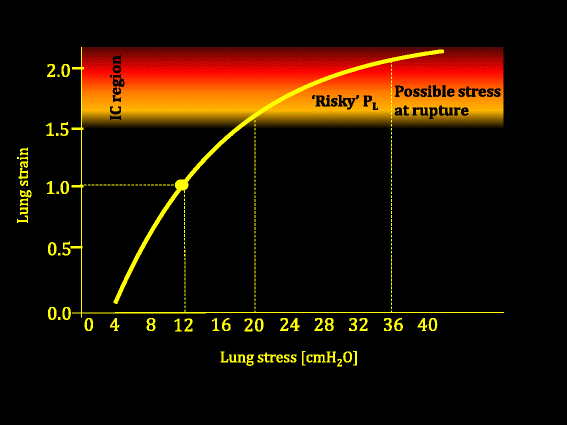

These patients have a prolonged expiratory phase, and therefore have difficulty exhaling the full volume before the ventilator delivers the next breath.

Patients with obstructive lung disease, COPD, and asthma are at risk of dynamic hyperinflation. These diseases are associated with either dynamic hyperinflation or poor lung compliance, both of which predispose patients to increased alveolar pressure and ultimately barotrauma. Specific disease processes, including chronic obstructive pulmonary disease (COPD), asthma, interstitial lung disease (ILD), pneumocystis jiroveci pneumonia, and acute respiratory distress syndrome (ARDS), may predispose individuals to pulmonary barotrauma. When managing a ventilator, physicians and other health care professionals must be aware of these risks to avoid barotrauma. However, certain ventilator settings, as well as specific disease processes, may increase the risk of barotrauma significantly. Elevation in the trans-alveolar pressure may lead to alveolar rupture, which results in leakage of air into the extra-alveolar tissue.Įvery patient on positive pressure ventilation is at risk of developing pulmonary barotrauma. Positive pressure ventilation may lead to elevation of the trans-alveolar pressure or the difference in pressure between the alveolar pressure and the pressure in the interstitial space. Pulmonary barotrauma results from positive pressure mechanical ventilation.

Patients at high risk of developing barotrauma from mechanical ventilation include individuals with predisposing lung pathology such as chronic obstructive pulmonary disease (COPD), asthma, interstitial lung disease (ILD), pneumocystis jiroveci pneumonia, and acute respiratory distress syndrome (ARDS). Mechanical ventilation modalities include invasive mechanical ventilation and non-invasive mechanical ventilation, such as bilevel positive airway pressure. The incidence of barotrauma in patients receiving non-invasive mechanical ventilation is much lower when compared to patients receiving invasive mechanical ventilation.

Excess alveolar air could then result in complications such as pneumothorax, pneumomediastinum, and subcutaneous emphysema. Barotrauma is most commonly due to alveolar rupture, which leads to an accumulation of air in extra alveolar locations. Pulmonary barotrauma is the presence of extra alveolar air in locations where it is not present under normal circumstance. Since positive pressure ventilation is not physiological, it may lead to complications such as barotrauma. In contrast, patients on mechanical ventilation ventilate with positive pressures. The natural mechanism of breathing in humans depends on negative intrathoracic pressures. Pulmonary barotrauma is a complication of mechanical ventilation and has correlations with increased morbidity and mortality. This article will focus on pulmonary barotrauma. Barotrauma is commonly observed in scuba divers, free-divers, or even in airplane passengers during ascent and descent. The most common organs affected by barotrauma are the middle ear (otic barotrauma), sinuses (sinus barotrauma), and the lungs (pulmonary barotrauma). Barotrauma is damage to body tissue secondary to pressure difference in enclosed cavities within the body.


 0 kommentar(er)
0 kommentar(er)
